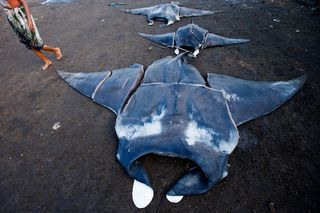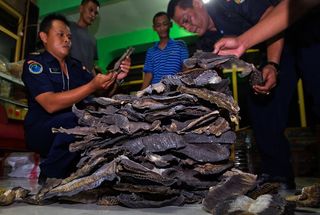Manta Ray Traffickers Busted in Indonesia

Authorities in Indonesia are cracking down on wildlife traffickers who illegally sell the parts of sharks, rays and other marine creatures.
In a series of arrests from August to September, police caught four people peddling the gills, snouts and other parts of rays, among other animal products, the Wildlife Conservation Society (WCS) announced.
On Aug. 22, in Surabaya, Indonesia, authorities arrested the owner of Sido Mampir Seafood, who was allegedly involved in a shipment of 28 lbs. (13 kilograms) of turtle meat and 110 lbs. (50 kg) of gill plates — nearly half of which came from manta rays newly protected under Indonesian law. [Marine Marvels: Spectacular Photos of Sea Creatures]

Then, on Sept. 1, police nabbed a trader who was allegedly trafficking 53 snouts of the critically endangered sawfish ray in Bali. On Sept. 9, authorities busted another trader in Sidoarjo, near Surabaya; during that arrest, police confiscated 1,231 lbs. (558 kg) of manta ray bones, as well as sea turtle scales, manta ray gill plates and nautilus shells.
In a final incident on Sept. 26 in West Java, a fisheries trader was apprehended after allegedly trying to sell an entire manta ray weighing 132 lbs. (60 kg).
Rays belong to the elasmobranch family, which also includes sharks. Manta ray gill plates are in increasingly high demand in Chinese markets for use in a health tonic. One kilogram (2.2 lbs.) of manta gill plates can fetch $250 to $500 in China, and the total trade is estimated to be worth $30 million annually, according to the WCS.
In February, the Indonesian Ministry of Marine Affairs and Fisheries banned the hunting and trading of manta rays throughout the country. The recent arrests mark the first law enforcement actions under those new regulations, WCS representatives said. A person caught trafficking manta rays and their parts faces a maximum fine of $25,000. For sawfish, sea turtle and nautilus parts, the penalty is a maximum of five years in prison and a $10,000 fine.
Sign up for the Live Science daily newsletter now
Get the world’s most fascinating discoveries delivered straight to your inbox.
"This arrest is a major first step in new enforcement efforts to protect sharks and rays in Indonesia, which operates the largest known shark and ray fisheries on Earth," Joe Walston, the WCS vice president for field conservation, said in a statement. "This arrest sends a clear message that Indonesia is serious about protecting its natural heritage against illegal wildlife traders."
The international community is also cracking down on shark and ray trading. Earlier this year, the Convention on International Trade in Endangered Species of Wild Fauna and Flora, known as CITES, decided to extend new protections to five species of sharks and all manta rays. Under the new regulations, which took effect Sept. 14, oceanic whitetips, porbeagles, three hammerhead species and manta rays are listed under Appendix II of the CITES Treaty. That means anyone who wants to export live or dead specimens needs a special permit. All species of sawfish rays are listed under Appendix I, which bans all trade, with rare exceptions.
Follow Megan Gannon on Twitter and Google+. Follow us @livescience, Facebook & Google+. Original article on Live Science.

